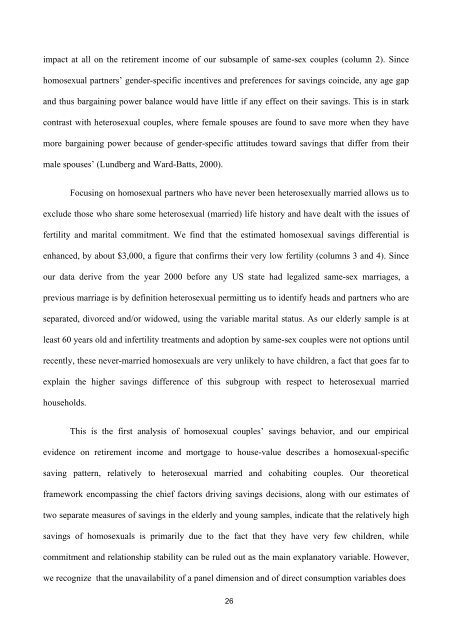Download PDF - Ivie
Create successful ePaper yourself
Turn your PDF publications into a flip-book with our unique Google optimized e-Paper software.
impact at all on the retirement income of our subsample of same-sex couples (column 2). Since<br />
homosexual partners’ gender-specific incentives and preferences for savings coincide, any age gap<br />
and thus bargaining power balance would have little if any effect on their savings. This is in stark<br />
contrast with heterosexual couples, where female spouses are found to save more when they have<br />
more bargaining power because of gender-specific attitudes toward savings that differ from their<br />
male spouses’ (Lundberg and Ward-Batts, 2000).<br />
Focusing on homosexual partners who have never been heterosexually married allows us to<br />
exclude those who share some heterosexual (married) life history and have dealt with the issues of<br />
fertility and marital commitment. We find that the estimated homosexual savings differential is<br />
enhanced, by about $3,000, a figure that confirms their very low fertility (columns 3 and 4). Since<br />
our data derive from the year 2000 before any US state had legalized same-sex marriages, a<br />
previous marriage is by definition heterosexual permitting us to identify heads and partners who are<br />
separated, divorced and/or widowed, using the variable marital status. As our elderly sample is at<br />
least 60 years old and infertility treatments and adoption by same-sex couples were not options until<br />
recently, these never-married homosexuals are very unlikely to have children, a fact that goes far to<br />
explain the higher savings difference of this subgroup with respect to heterosexual married<br />
households.<br />
This is the first analysis of homosexual couples’ savings behavior, and our empirical<br />
evidence on retirement income and mortgage to house-value describes a homosexual-specific<br />
saving pattern, relatively to heterosexual married and cohabiting couples. Our theoretical<br />
framework encompassing the chief factors driving savings decisions, along with our estimates of<br />
two separate measures of savings in the elderly and young samples, indicate that the relatively high<br />
savings of homosexuals is primarily due to the fact that they have very few children, while<br />
commitment and relationship stability can be ruled out as the main explanatory variable. However,<br />
we recognize that the unavailability of a panel dimension and of direct consumption variables does<br />
23

















